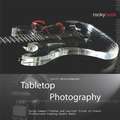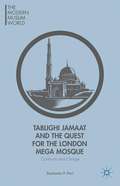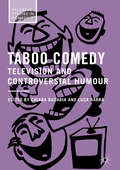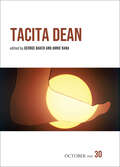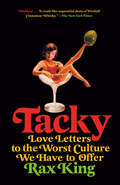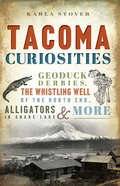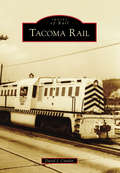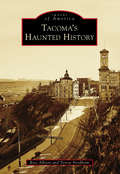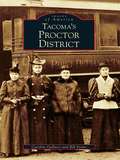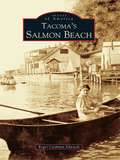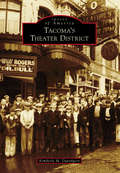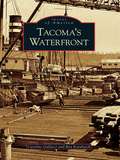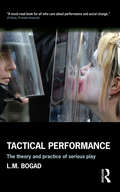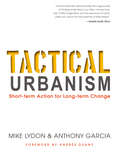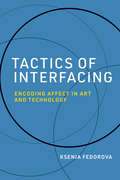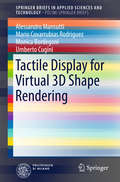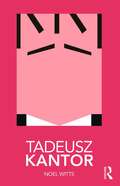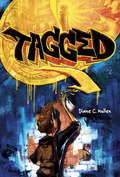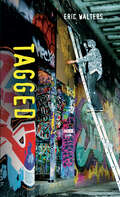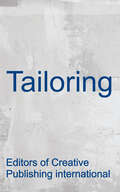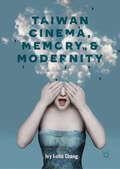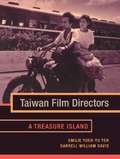- Table View
- List View
Tabletop Gardens: How to Make Long-Lasting Arrangements for Every Season (Living with Plants)
by Baylor ChapmanHow to Create Stunning Living Centerpieces Adapted from plant designer Baylor Chapman's The Plant Recipe Book, here are thirty projects for beautiful planted centerpieces. Instead of picking up fresh-cut flowers from the supermarket or florist, discover how to create lasting flower arrangements using living plants. From plant designer Baylor Chapman, here are thirty projects for beautiful centerpieces. Each project specifies the type and number of plants needed and the best containers to use, plus techniques and expert advice for helping that tabletop garden grow.
Tabletop Photography
by Cyrill HarnischmacherImagine capturing stunning, professional-looking product shots without needing a studio filled with expensive equipment and large flash units. This book teaches all the steps for creating your own tabletop photography studio. Affordable compact flashes offer a number of creative lighting options within your tabletop studio; and the appropriate lighting and backdrop, and the creative use of your camera's features are key to a perfect image. Author Cyrill Harnischmacher guides you through a variety of exposure and lighting techniques, and covers how to achieve excellent results using compact flash units. Whether you wish to capture product images for use in print or on the web, or you want to improve your photos for personal use, this book will provide you with everything you need to know to get great results. Topics include: Lighting Setups; Reflectors, Diffusors, and Accessories; Soft Boxes and Umbrellas; Strobe Flashes; Combining Long Exposures with Flashlights; Multi-Flash Exposures; Composition and Arrangements; Creating Backdrops; Product Photography; Smoke, Fog, and Special Effects; Food Photography and much more...
Tablighi Jamaat and the Quest for the London Mega Mosque
by Zacharias P. PieriThe book charts the attempts of Islam's largest missionary movement, the Tablighi Jamaat, to build Europe's largest mosque in London. Key themes include how Islamic movements engage and adapt within liberal democracies and how local contexts are key in understanding how and why movements operate in a given way.
Taboo Comedy
by Chiara Bucaria Luca BarraThe essays in this collection explore taboo and controversial humour in traditional scripted (sitcoms and other comedy series, animated series) and non-scripted forms (stand-up comedy, factual and reality shows, and advertising) both on cable and network television. Whilst the focus is predominantly on the US and UK, the contributors also address more general and global issues and different contexts of reception, in an attempt to look at this kind of comedy from different perspectives. Over the last few decades, taboo comedy has become a staple of television programming, thus raising issues concerning its functions and appropriateness, and making it an extremely relevant subject for those interested in how both humour and television work.
Tacita Dean (October Files)
by George Baker Annie RanaA highly anticipated and richly illustrated anthology of essays on the work of artist Tacita Dean.This volume explores the deeply-influential work of Tacita Dean, recognized increasingly as one of the key artists of our times. Emerging initially as part of the generation of the so-called Young British Artists in the 1990s, Dean has reinvented the manner in which artists use analogue mediums such as drawing, photography, and film, prompting major questions in her work around the issues of time, memory, and history.Dean&’s films embrace long takes that achieve a near-photographic stillness; they have been dedicated to obsolescent objects or stranded buildings, failed quests, and extraordinary figures—usually other artists and writers—nearing the end of their lives. But Dean&’s contemplative films have been rigorously reinvented as a form over the course of her career and linked to a widening series of projects involving writing, chalk drawings, found photographs, dance, and theater. This anthology explores the artist&’s expansive practice, gathering essays and interviews by authors from an array of disciplines including art criticism, philosophy, literature, and film. Spanning twenty-five years of the artist&’s career, the volume includes writings by George Baker, Douglas Crimp, Brian Dillon, Briony Fer, Hal Foster, Mark Godfrey, Louise Hornby, Rosalind Krauss, Elisabeth Lebovici, Jean-Luc Nancy, Tamara Trodd, Marina Warner, Peter Wollen, and the artist herself.
Tacky: Love Letters to the Worst Culture We Have to Offer
by Rax KingAn irreverent and charming collection of deeply personal essays about the joys of low pop culture and bad taste, exploring coming of age in the 2000s in the age of Hot Topic, Creed, and frosted lip gloss. <p><p> Tacky is about the power of pop culture—like any art—to imprint itself on our lives and shape our experiences, no matter one's commitment to "good" taste. These fourteen essays are a nostalgia-soaked antidote to the millennial generation's obsession with irony, putting the aesthetics we hate to love—snakeskin pants, Sex and the City, Cheesecake Factory's gargantuan menu—into kinder and sharper perspective. Each essay revolves around a different maligned (and yet, Rax would argue, vital) cultural artifact, providing thoughtful, even romantic meditations on desire, love, and the power of nostalgia. An essay about the gym-tan-laundry exuberance of Jersey Shore morphs into an excavation of grief over the death of her father; in "You Wanna Be On Top," Rax writes about friendship and early aughts girlhood; in another, Guy Fieri helps her heal from an abusive relationship. The result is a collection that captures the personal and generational experience of finding joy in caring just a little too much with clarity, heartfelt honesty, and Rax King's trademark humor.
Tacoma Curiosities: Geoduck Derbies, the Whistling Well of the North End, Alligators in Snake Lake & More
by Karla StoverWhen the Northern Pacific Railroad laid its final tracks within the fledgling hamlet of Tacoma, it brought opportunity and wild characters by the car full. Seemingly overnight, the quiet Puget Sound village transformed into a booming metropolis and eccentric playground with its fair share of growing pains. On one unlucky evening, residents awoke to the cries of a man who fell into the sewers after a road collapsed. Tacoma's first school avoided demolition for a time thanks to a band of enterprising tramps who converted the place of learning into Hotel de Gink, complete with unique minstrel show. Local author and guide Karla Stover explores these and many more stories of the quixotic and curious history of the City of Destiny.
Tacoma Rail
by David J. CantlinCome along for the journey that is today's Tacoma Rail, from its humble beginning as a rickety trolley line to the economic engine that helps power the Port of Tacoma and surrounding communities. Once called the "Step Child Utility," today, Tacoma Rail moves more than 82,000 rail shipments on 204 miles of track annually and contributes more than $1.6 million in tax revenues to the city of Tacoma.
Tacoma's Haunted History (Images of America)
by Ross Allison Teresa NordheimTacoma hides in the shadows of Seattle, but what hides in the shadows of Tacoma? The city's paranormal history is riddled with Native American culture, spiritualists, mysterious deaths, tragedy, and curses that dwell in the dark. Much of Tacoma is built directly on top of sacred lands, and many natives to the area can attest that the city is haunted by its past. Desecration of graves can leave troubling results. Hexed citizens can perish. An untimely death can leave behind a soul. These unfortunate circumstances bring forth tales of the strange and unexplainable. Are we alone in Tacoma or accompanied by ghosts of the past?
Tacoma's Proctor District (Images of America)
by Bill Evans Caroline GallacciWhen Allen C. Mason launched his Point Defiance line in the early 1890s, the Proctor area became one of Tacoma's first streetcar suburbs. Before this time, Tacoma's North End was a remote, unsettled region populated only by those visiting the city's horseracing track. After Mason established a streetcar stop at the intersection of North Twenty-sixth and Proctor Streets--near the racetrack--businesses began to line the thoroughfare. By 1900, houses had been constructed within walking distance of the line, and a residential neighborhood provided the impetus for the construction of schools, a firehouse, churches, and a library. By the 1920s, the neighborhood had expanded and changed to reflect the introduction of the automobile as well as the district's popularity with University of Puget Sound students studying nearby. The community spirit that emerged then continues to this day.
Tacoma's Salmon Beach
by Roger Cushman EdwardsPerched on the shores of the Tacoma Narrows, the community of Salmon Beach overlooks the spectacular Tacoma Narrows Bridge. Built as a series of fishing shacks on the beach, Salmon Beach took on a more permanentflavor after Henry O. Foss towed his two-story boathouse from the city to the tidelands south of Point Defiance. After electricity was introduced in 1934, more comfortable cottages were built in this fishing community. From summer beach camping to an isolated refuge in the middle of a city, a haven for rumrunners during Prohibition to the counterculture enclave of the 1960s, the community of Salmon Beach has weathered fires, evictions, landslides,and government caprice to become the unique neighborhood of Tacoma it is today.
Tacoma's Theater District
by Kimberly M. DavenportThe history of Tacoma's Theater District is nearly as long as that of the city of Tacoma itself, spanning from the opening of the Tacoma Theater in 1890 to the present day, with restored historical facilities anchoring a renewed cultural district. This telling of the district's history reflects a range of engaging topics, including the boundless enthusiasm of the initial residents of Tacoma (the "City of Destiny"), the changing ways in which culture was shared and experienced over the decades of the 20th century, and a community working together through difficult times to save and restore historical buildings as gathering spaces for the benefit of future generations. The story is told through historical photographs of the theater venues themselves, as well as images capturing a myriad of cultural and community events taking place in those facilities and in the surrounding district.
Tacoma's Waterfront (Images of America)
by Ron Karabaich Caroline GallacciFor more than 150 years, the activity on and around Commencement Bay-since the 1840s, when Charles Wilkes first named it, to the present day-has been a barometer for measuring Tacoma's maritime and industrial growth and development. Wilkes's early exploration assured the inclusion of Puget Sound within the boundaries of the United States following negotiations with Great Britain in 1846. Drawn to the deep waters of the south shore of the bay, the Northern Pacific Railroad established its transcontinental terminus here in 1873 and, in the process, created the city of Tacoma. In the early years, the waterfront was alive with the sights and sounds of commerce. The "longest wheat wharf in the world" lined the south shoreline, longshoremen handled cargo, the Mosquito Fleet carried people to and from the municipal dock, and the Puyallup River delta was transformed into the bustling Port of Tacoma.
Tactical Media (Electronic Mediations #28)
by Rita RaleyTactical media describes interventionist media art practices that engage and critique the dominant political and economic order. Rather than taking to the streets and staging spectacular protests, the practitioners of tactical media engage in an aesthetic politics of disruption, intervention, and education. From They Rule, an interactive map of the myriad connections between the world&’s corporate and political elite created by Josh On and Futurefarmers, toBlack Shoals, a financial market visualization that is intended to be both aesthetically and politically disruptive, they embrace a broad range of oppositional practices.In Tactical Media, Rita Raley provides a critical exploration of the new media art activism that has emerged out of, and in direct response to, postindustrialism and neoliberal globalization. Through close readings of projects by the DoEAT group, the Critical Art Ensemble, Electronic Civil Disobedience, and other tactical media groups, she articulates their divergent methods and goals and locates a virtuosity that is also boldly political. Contemporary models of resistance and dissent, she finds, mimic the decentralized and virtual operations of global capital and the post-9/11 security state to exploit and undermine the system from within. Emphasizing the profound shift from strategy to tactics that informs new media art-activism, Raley assesses the efficacy of its symbolic performances, gamings, visualizations, and hacks. With its cogent analyses of new media art and their social impact, Tactical Media makes a timely and much needed contribution to wider debates about political activism, contemporary art, and digital technology.
Tactical Performance: Serious Play and Social Movements
by Larry BogadTactical Performance tells fun, mischievous stories of underdogs speaking mirth to power - through creative, targeted activist performance in the streets of cities around the world. This compelling, inspiring book also provides the first ever full-length practical and theoretical guide to this work. L.M.Bogad, one of the most prolific practitioners and scholars of this genre, shares the most effective non-violent tactics and theatrics employed by groups which have captured the public imagination in recent years. Tactical Performance explores carnivalesque protest in unique depth, looking at the possibilities for direct action and sometimes shocking confrontation with some of the most powerful institutions in the world. It is essential reading for anyone interested in creative pranksterism and the global justice movement.
Tactical Urbanism: Short-term Action for Long-term Change
by Mike Lydon Anthony Garcia Andres DuanyIn the twenty-first century, cities worldwide must respond to a growing and diverse population, ever-shifting economic conditions, new technologies, and a changing climate. Short-term, community-based projects--from pop-up parks to open streets initiatives--have become a powerful and adaptable new tool of urban activists, planners, and policy-makers seeking to drive lasting improvements in their cities and beyond. These quick, often low-cost, and creative projects are the essence of the Tactical Urbanism movement. Whether creating vibrant plazas seemingly overnight or re-imagining parking spaces as neighborhood gathering places, they offer a way to gain public and government support for investing in permanent projects, inspiring residents and civic leaders to experience and shape urban spaces in a new way. Tactical Urbanism, written by Mike Lydon and Anthony Garcia, two founders of the movement, promises to be the foundational guide for urban transformation. The authors begin with an in-depth history of the Tactical Urbanism movement and its place among other social, political, and urban planning trends. A detailed set of case studies, from guerilla wayfinding signs in Raleigh, to pavement transformed into parks in San Francisco, to a street art campaign leading to a new streetcar line in El Paso, demonstrate the breadth and scalability of tactical urbanism interventions. Finally, the book provides a detailed toolkit for conceiving, planning, and carrying out projects, including how to adapt them based on local needs and challenges. Tactical Urbanism will inspire and empower a new generation of engaged citizens, urban designers, land use planners, architects, and policymakers to become key actors in the transformation of their communities.
Tactics of Interfacing: Encoding Affect in Art and Technology (Leonardo)
by Ksenia FedorovaHow digital technologies affect the way we conceive of the self and its relation to the world, considered through the lens of media art practices.In Tactics of Interfacing, Ksenia Fedorova explores how digital technologies affect the way we conceive of the self and its relation to the world. With the advent of ubiquitous computing, the self becomes an object of technological application, increasingly defined by data received from tracking technologies. Subtly, these technologies encourage versions of ourselves that are easier to interpret computationally. Fedorova views these shifts in self-perception through the lens of contemporary media art practices, examining a range of artistic tactics that enable embodied and intimate experiences of machinic operations on our lives.
Tactile Display for Virtual 3D Shape Rendering
by Monica Bordegoni Alessandro Mansutti Mario Covarrubias Rodriguez Umberto CuginiThis book describes a novel system for the simultaneous visual and tactile rendering of product shapes which allows designers to simultaneously touch and see new product shapes during the conceptual phase of product development. This system offers important advantages, including potential cost and time savings, compared with the standard product design process in which digital 3D models and physical prototypes are often repeatedly modified until an optimal design is achieved. The system consists of a tactile display that is able to represent, within a real environment, the shape of a product. Designers can explore the rendered surface by touching curves lying on the product shape, selecting those curves that can be considered style features and evaluating their aesthetic quality. In order to physically represent these selected curves, a flexible surface is modeled by means of servo-actuated modules controlling a physical deforming strip. The tactile display is designed so as to be portable, low cost, modular, and high performing in terms of the types of shape that it can represent.
Tadeusz Kantor (Routledge Performance Practitioners)
by Noel WittsTadeusz Kantor – a theoretician, director, innovator and painter famed for his very visual theatre style – was a key figure in European avant-garde theatre. He was also known for his challenging theatrical innovations, such as extending stages and the combination of mannequins with living actors. The book combines: a detailed study of the historical context of Kantor’s work an exploration of Kantor’s own writings on his theatrical craft a stylistic analysis of the key works, including The Dead Class and Let the Artists Die, and their critical reception an examination of the practical exercises devised by Kantor. As a first step towards critical understanding, and as an initial exploration before going on to further, primary research, Routledge Performance Practitioners offer unbeatable value for today’s student.
Tagged
by Diane C. MullenLiam is a fourteen-year-old graffiti artist living in project housing in Minneapolis with his single mother and two younger siblings. When Liam's estranged older brother coerces him to tag a graffiti symbol for a rival gang, Liam's life is threatened. Due to his apathetic attitude in the classroom and on the baseball field, Liam's private-school scholarship is also threatened. His mother decides to send him to Lake Michigan for the summer to live with her best friend, Kat, a sculptor and art teacher, Liam soon delves into the work of Jean-Michel Basquiat, Pablo Picasso, and his own personal aesthetics. He's encouraged to consider his art seriously and how it might contribute to a greater community. Having to decide between staying with Kat and returning home to his siblings who need him, Liam's story inspires him to reinvent himself for the better.
Tagged (Orca Soundings)
by Eric WaltersThe city is cracking down on graffiti and guerilla art. Between that and cutbacks to the local art gallery it seems like nothing is safe. But Oswald, masquerading as a graffiti artist known as The Wiz, is fighting back--by painting elaborate murals in public places and planting art in the galleries, and then by taking on the mayor himself. As the fight escalates and the stakes become higher, Oswald gets in deeper than he meant to and needs to rely on his friends to get him out of his latest mess.
Tailoring: The Classic Guide to Sewing the Perfect Jacket
by Editors of Creative Publishing internationalWritten by sewing professionals, this book teaches the trusted, proven methods for sewing tailored jackets with impeccable details and perfect fit. Written for the intermediate sewer who wants to move on to more challenging projects, this book ensures success with detailed, step-by-step instructions, more than 400 photos, in-depth discussions about products and how to use them.
Tails from the Exotic Feline Rescue Center, 25th Anniversary Edition
by Bill Nimmo Joe Taft Stephen D. MccloudMeet Sahib, Sampson, Zulu, Rouge, Blaze--just a few of the 200 big cats that await visitors at the Exotic Feline Rescue Center. The EFRC, in Center Point, Indiana, is a nationally recognized leader in big cat rescue, conservation, and care. Almost all of these cats--tigers, bobcats, lions, pumas, and servals--are survivors of abuse and neglect. In this follow-up to Saving the Big Cats and Real Stories of Big Cat Rescues, photographer Stephen D. McCloud showcases the newest residents of this lush 108-acre sanctuary, now celebrating its 25th anniversary. Readers will be fascinated by the stories of these incredible feline predators in this anniversary edition, which includes a foreword by Tigers of America founder Bill Nimmo.
Taiwan Cinema, Memory, and Modernity
by Ivy I-chu ChangThis book investigates the aesthetics and politics of Post/Taiwan-New-Cinema by examining fifteen movies by six directors and frequent award winners in international film festivals. The book considers the works of such prominent directors as Edward Yang, Tsai Ming-liang and Chang Tsuo-chi and their influence on Asian films, as well as emergent phenomenal directors such as Wei Te-sheng, Zero Chou, and Chung Mong-hong. It also explores the possibility of transnational and trans-local social sphere in the interstices of layered colonial legacies, nation-state domination, and global capitalism. Considering Taiwan cinema in the wake of globalization, it analyses how these films represent the socio-political transition among multiple colonial legacies, global capitalism, and the changing cross-strait relation between Taiwan and the Mainland China. The book discusses how these films represent nomadic urban middle class, displaced transnational migrant workers, roaming children and young gangsters, and explores how the continuity/disjuncture of globalization has not only carved into historical and personal memories and individual bodies, but also influenced the transnational production modes and marketing strategies of cinema.
Taiwan Film Directors: A Treasure Island (Film and Culture Series)
by Emilie Yueh-yu Yeh Darrell William DavisFocusing on the work of four contemporary filmmakers—Ang Lee, Edward Yang, Hou Hsiao-hsien, and Tsai Ming-liang—the authors explore how these filmmakers broke from tradition, creating a cinema that is both personal and insistent on examining Taiwan's complex history. Featuring stills, anecdotes, and close readings of films, the authors consider the influence of Hong Kong and martial arts films, directors' experiments with autobiography, the shifting fortunes of the Taiwanese film industry, and Taiwan cinema in the context of international cinema's aesthetics and business practices.

